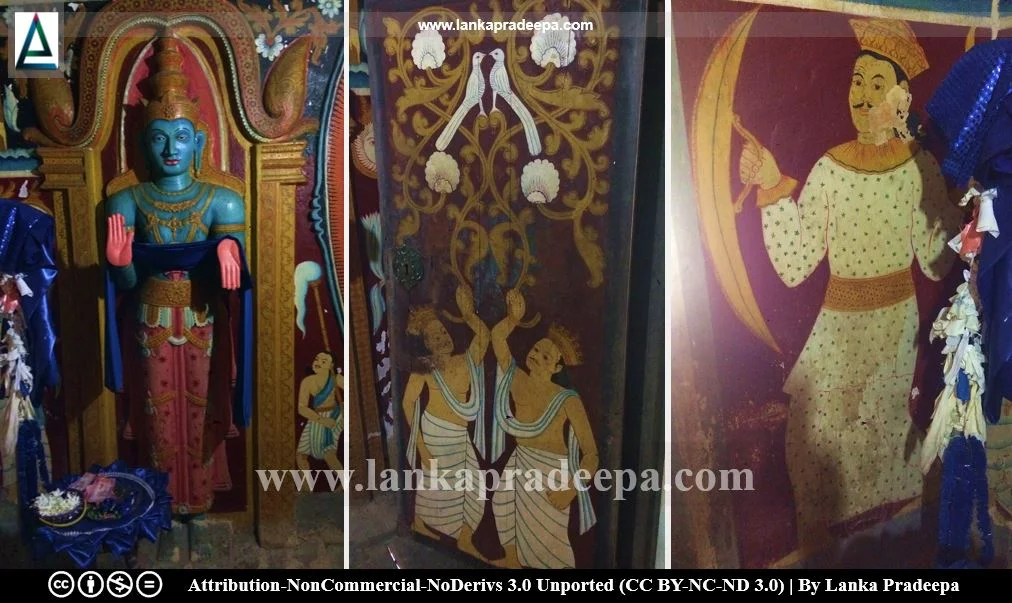
Kshetrarama Purana Tempita Viharaya is a Buddhist temple situated in Hapuwalana village in Gampaha District, Sri Lanka.
History
The Buddha Sasana which was in a state of decline started to revive again in the latter part of the Kandyan Period, and during this period many Buddhist Viharas and Pirivenas bloomed throughout the country. The Buddhist monk named Kinigoda Brahmasosatha Thera who was educated and ordained at one of the Pirivenas established at the time improved a number of Buddhist temples including the Hapuwalana Viharaya (Chandrasoma, 2013).
Tempita Viharaya
Tempita Viharas (the temples on pillars) were a popular aspect of many
Buddhist temples during the Kandyan period. These structures were usually built on a wooden platform resting on bare stone pillars or stumps which are about 1-4 feet tall. The roof is generally made of timber and held by wooden stumps. The walls are usually made of wattle and daub and they form the main enclosed shrine room containing the Buddhist sculptures and murals belonging to the Kandyan style. Some Tempita
Viharas have narrow verandas and ambulatories circulating the main enclosed space. Construction of these buildings was started in the 17th
century and lasted until the end of the 19th century (Wijayawardhana,
2010).
Hapuwalana Tempita Viharaya
The Tempita Viharaya is the main aspect of this temple with archaeological value. It has been built upon 25 granite pillars of about 2 feet 6 inches tall (Chandrasoma, 2013). The
four-sided roof with an elevated middle portion is paved with flat clay
tiles. The shrine is 31 feet long and 17 feet 5 inches wide and can be entered through a flight of steps (Chandrasoma, 2013). It consists of two sections, viz: the inner chamber and the outer ambulatory. The ambulatory which surrounds the inner chamber is 2 feet 8 inches wide (Chandrasoma, 2013). The walls of the outer ambulatory rise up to the roof level and therefore, completely covers the inner chamber. However, three windows are fixed at each side of the shrine (except the front wall) to bring the light inside. Besides the main entrance, another door has been provided on the left-side wall of the ambulatory. Although, the walls of the outer ambulatory contains no paintings or decorations, fragments of two faded paintings depicting the Vessantara Jataka are found on the inner side of the front wall of the ambulatory.
The front wall of the inner chamber has been decorated with a Makara Thorana (a dragon arch) and sculptures of deities. A door guarded with two door-keepers has been provided to enter into the inner chamber. A seated Buddha statue accompanied by two images of Sariputta and Moggallana, the two chief disciples of Gautama Buddha is found inside the chamber. Two standing statues of Buddha are also found facing each other at both left and right walls. The space of the inside as well as the outside walls of the inner chamber have been filled with the paintings
belonging to the Kandyan style.
A small open-hall has been built in front of the Tempita shrine recently.
A protected site
The Tempita Shrine and Pohoya Seemawa at the premises of Kshestrarama Purana Vihara in Hapuwana village situated
in the Grama Niladhari Division No. 87, Hapuwalana in the Divisional Secretary’s Division of Divulapitiya are archaeological protected monuments, declared by a government gazette notification published on 9 March 2016.


 .
.
References
1) Chandrasoma, S., 2013. Gampaha Distrikkaye Tempita Vihara (In Sinhala). Department of Archaeology (Sri Lanka). Colombo. ISBN: 978-955-9159-85-8. pp.63-68.
2) The Gazette of the Democratic Socialist Republic of Sri Lanka: Extraordinary. No: 1957/18. 9 March 2016. p.5A.
2) The Gazette of the Democratic Socialist Republic of Sri Lanka: Extraordinary. No: 1957/18. 9 March 2016. p.5A.
3) Wijayawardhana, K., 2010. Sri Lankawe Tampita Vihara (In Sinhala). Dayawansa Jayakody & Company. Colombo. ISBN: 978-955-551-752-2. p. 12.
Location Map
This page was last updated on 3 October 2020
For a complete tourist map follow this link: Lankapradeepa Tourist Map
For a complete tourist map follow this link: Lankapradeepa Tourist Map


